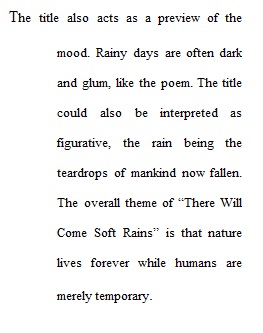


Q Instructions Purpose: This assignment will enable you to discover a short story's use of elements such as theme, irony, metaphor, and symbolism. You will conduct a close reading of a short story and discuss the author's use of these devices in his or her structuring and composition of the content. Applying a close reading and composing a literary analysis will prepare you for the many texts that you will read, summarize, and discuss in the workplace. Task: Write an essay analyzing one of our stories from this Unit that discusses why and how specific symbols, metaphors, or uses of irony are used to depict one or two of the themes from Unit 1 in a particular way. Your essay should incorporate details and quotes from the story (using parenthetical documentation with the author's name), and you should use your own words to elaborate on the meanings of the details and quotes you use as evidence. Review your feedback from the Unit 3 Discussion on Analyzing a Short Story, as well as the posts and feedback of your classmates. Follow these steps: Choose one of the Short Story Selections from this Unit - you can certainly choose the same story you started to analyze in your Discussion, but you don't have to. Your analysis might, however, benefit from the feedback you received in the Discussion, as well as the posts and responses of your classmates. You will closely read your chosen story, considering its themes, characters, organization, dialogue, and other literary elements. Take notes to outline later. Read and reread the story; by paying attention to the varied features of the story, your awareness of these literary elements and how they build the story's meaning will grow. Start to compose your outline and working thesis about literary devices the author uses, and how they contribute to the theme or themes you've identified. See the Irony and Alienation in "Everything That Rises Must Converge" page as an example of how to approach your analysis. Take your working thesis and build your introductory paragraph, making sure to lay out your main points. Following your close reading of the story, draft your remaining paragraphs, providing textual evidence from the story to support each of your main points. See the Starting Your Short Story Analysis Essay page for an outline of how to proceed. Finally, write a conclusion, restating your thesis in such a way to encompass greater issues of time periods, cultural movements, or a lens of literary criticism through which the story and your identified theme(s) can be viewed. Be sure to maintain an appropriate academic tone (no slang, second-person ["you," "we"], contractions, etc.) Please refer to the Purdue Online Writing Lab for MLA formatting and style guide. Leave time to submit your draft to Free Tutoring for review. Your tutor can help with thesis and content development, organization, grammar, and mechanics. Utilize this free service to write the best draft possible on this major assignment. Don't forget that you can submit your draft to Free Tutoring multiple times during the revision process. Submit your final paper in Turnitin, OR in the assignment dropbox, according to your instructor's preference. Should you use Turnitin, make sure to take a screenshot of the confirmation screen once you upload your paper. When writing your essay, the goal is to demonstrate what spin the story has on a particular theme. Be specific about the ways the theme is used and how the story's use of symbols develops a deeper meaning to the theme. Provide details, including cited direct quotes from the story, but don't forget that you must comment on the quotes you use to explain why they are significant. Criteria on Which You Will be Graded: The specificity and development of your thesis Your supporting claims, logic, and organization The quality of your writing, to include paragraph development and organization: topic sentences, conclusions, transitions, etc. See Starting Your Short Story Analysis Essay. Your engagement with the text (how you explain your examples, your choice of supporting quotations) Format: You are required to use MLA style for all writing assignments. Proper MLA citation and a correctly formatted Works Cited page (12-point font, Times New Roman, double spacing, Last name and page number on each page, etc.). Please refer to the Purdue Online Writing Lab for MLA formatting and style guide. Academic Honesty (all sources must be cited) Length Requirement: 750-1000 words
View Related Questions